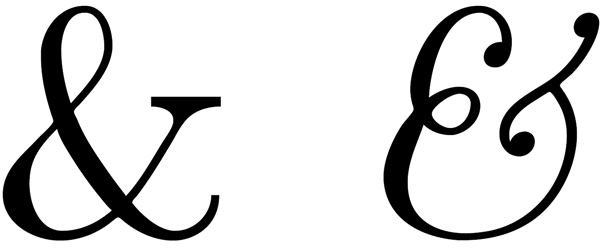And vs. Ampersand (&) Usage: When Can the Ampersand (&) Be Used?
Some Background on the Ampersand
Although many people recognize that the ampersand (&) appears in place of “and” in daily communications, English usage rules exist that govern its use. To help you avoid embarrassing writing mistakes, learn the proper way to use the ampersand here.
Dating back to the first century, the ampersand has a rich heritage that began when a ligature comprised of the letters “e” and “t” developed. A ligature is when two letters combine to form only one glyph. Since then, the Latin language has influenced the ligatures commonly used, keeping the ampersand while discarding many others.
The current form of the ampersand in use is often written by hand as a plus sign with a loop extending from the bottom point of the vertical component coming halfway up to form the horizontal component. A backwards three with a vertical line through it also represents the ampersand in handwritten form.
The advent of SMS and Twitter have led to a more widespread use of the ampersand in daily life. Because it is only one character, it is frequently substituted for “and” as a space-saving effort. Let’s get started and discuss when it is acceptable to use the ampersand.
So When Can You Use It?
SMS and Twitter aside, the ampersand in standard English usage and composition should follow these rules:
- Business names. Using the ampersand as part of a business name is appropriate. An example of this is Dun & Bradstreet. Also, many attorneys with multiple partners connect their names with an ampersand.
- Addresses. Letters addressed to two people. For example, you may address your envelope like this: “Mr. & Mrs. Smith.”
- Citing sources. When more than one author appears in a citation, use an ampersand to connect the last two (Nevid, Rathus, & Greene, 2008). Keep in mind that some styles such as APA use the ampersand here while others such as Chicago write out the word “and.” If you have questions about this, be sure to consult your appropriate style handbook.
- Screenplay. When more than one name is attributed to a screenplay, the ampersand is used to connect the final two names.
- Et cetera. Sometimes et cetera is abbreviated using an ampersand rather than the beginning “et.” In other words, English usage permits either &c. or etc.
- Programming and special characters. Most programming languages use the ampersand for concatenation, comparison operations, and other purposes. Programs such as Microsoft Excel also have special uses for the ampersand.
Except for these uses, always use “and.”
Other Considerations
Languages other than English also use the ampersand, and those languages have different ampersand usage rules. If you are writing in a language such as French, German, or Spanish, for example, consult your language references for the applicable rules.
References
- Image Credit: Wikimedia Commons/Spider
